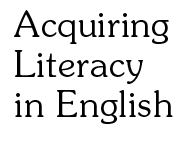Acquiring Literacy in English:
Crosslinguistic, Intralinguistic, and Developmental Factors
Subproject 3: Spelling as an Indicator of English Literacy Development
| Principal Investigator: | Elizabeth Howard, Center for Applied Linguistics |
| Co-Investigator: | Catherine Snow, Harvard Graduate School of Education |
Purpose
Study Subjects
Study Findings
Further Information
PURPOSE
Subproject 3 was a longitudinal study of spelling as an indicator of English literacy development. The study followed the spelling and reading development of students in seven schools from second through fifth grade. It began in fall 2000 and continued through spring 2006.
The study focused on the development of spelling and reading skills in native-Spanish-speaking and native-English-speaking students in Spanish-English bilingual educational settings. The researchers investigated three main questions:
- What is the nature of English spelling development for Spanish-English bilingual students in grades 2 through 5?
- What is the relationship between English spelling development and Spanish spelling development for Spanish-English bilingual students in grades 2 through 5?
- What is the relationship between English spelling development and English reading development for Spanish-English bilingual students in grades 2 through 5?
STUDY SUBJECTS
The subjects of the study were approximately 275 students, half of whom were native Spanish speakers and the other half of whom were native English speakers (the exact numbers changed over time due to attrition). Each student was enrolled in one of three types of educational programs:
- Spanish dominant (90/10) two-way immersion
- Balanced (50/50) Spanish-English two-way immersion
- Monolingual English
Each type of program had both native-Spanish-speaking and native-English-speaking students in it. Approximately 40 native English speakers in the monolingual English program served as a comparison group.
STUDY FINDINGS
The main findings from this study are summarized below in reference to the three research questions.
Research Question 1: What is the nature of English spelling development for Spanish-English bilingual students in grades 2 through 5?
Findings: Both native Spanish speakers and native English speakers experienced significant growth in English and Spanish spelling from grade 2 through 5. While the mean Spanish spelling performance of both language groups was almost indistinguishable, the mean English spelling performance of native Spanish speakers tended to lag behind that of native English speakers at all grade levels..
Research Question 2: What is the relationship between English spelling development and Spanish spelling development for Spanish-English bilingual students in grades 2 through 5?
Findings: There were significant, positive correlations between English and Spanish spelling ability for both language groups at all grade levels. Moreover, there was little evidence of negative spelling transfer for the bilingual students. In fact, cross-linguistic (that is, Spanish-influenced) spelling errors in English were never of very high frequency, and were virtually eliminated by fourth grade. Additionally, cross-linguistic spelling errors were not significantly associated with fifth grade reading outcomes. Thus, they appear to be part of a natural developmental progression for some Spanish-English bilingual students, and do not seem to represent a long-term literacy concern.
Research Question 3: What is the relationship between English spelling development and English reading development for Spanish-English bilingual students in grades 2 through 5?
Findings: English spelling is a significant predictor of English reading comprehension. Controlling for English and Spanish vocabulary ability and English and Spanish decoding ability, as well as the effects of school, there was a positive, significant effect of English spelling on English reading comprehension in a two-level growth model based on student performance in grades 2 through 5. This finding provides empirical evidence that spelling ability is an important ongoing factor in English reading development.
FURTHER INFORMATION
Read subproject summary [PDF, 36 KB] ![]()
View list of publications resulting from the study
Read descriptions of assessments developed for the study
- Parent Interview Response Sheet
- Developmental Contrastive Spelling Test (English and Spanish)
- Developmental Contrastive Decoding Test (English)

